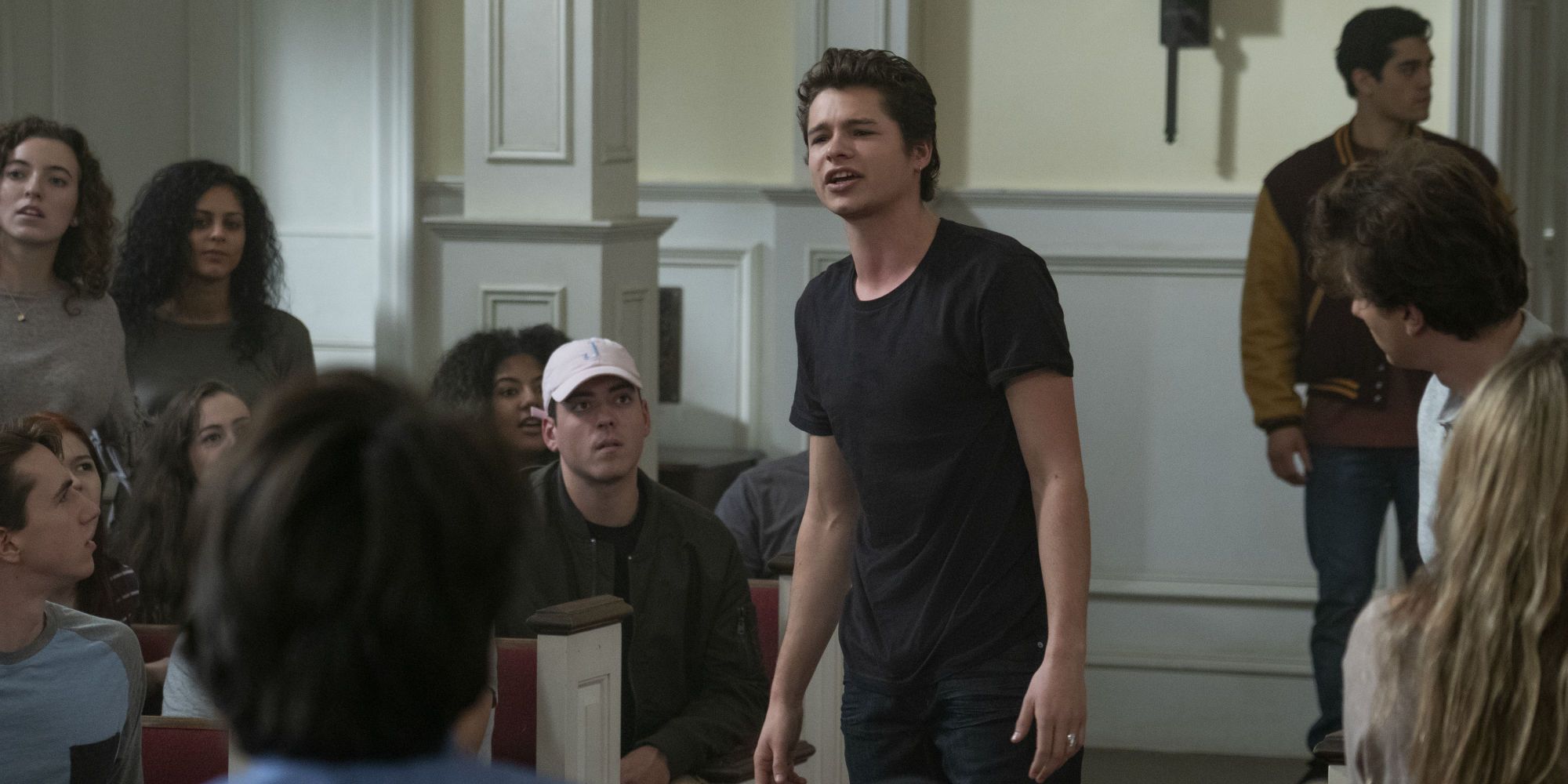WARNING: Major spoilers for The Society season 1 ahead.
Netflix’s The Society season 1 ending underlines the show’s exploration of the differences between dystopian and utopian societies. A terrible smell overtakes the town of West Ham, and teenagers board a bus for a school trip. Bad conditions force them home, and they soon discover that New Ham looks and feels different – no smell (bonus), no adults (double bonus). The Society season 1 raises questions about life ideals, and what happens when young adults are forced to think for themselves.
In The Society season 1, the main characters have different perceptions of chaos and order. Allie Press (Pokémon Detective Pikachu‘s Kathryn Newton) has lived under the shadow of her sister Cassandra (Rachel Keller), and begins the series as a passive-aggressive skeptic. Meanwhile, Campbell Eliot (Toby Wallace) emerges as the bad boy of The Society season 1; a rebellious character who challenges organization and structure. When Cassandra is shockingly murdered, Allie is chosen to protect the residents of New Ham, and therein lies the primary conflict for The Society season 1. As the power dynamics constantly shift, various characters seek more agency and question Allie’s decision-making. On the surface, The Society season 1 examines teen social dynamics, and the alternate dimension premise allows for a narrative study on sociopolitical concepts. Meanwhile, the supernatural subtext teases what’s to come in The Society season 2.
The Society season 1 suggests that New Ham is a dystopian society; a place that doesn’t actually seem too desirable. But as “The Committee for Going Home” learns more about the alternate dimension, some characters embrace their roles in the Brave New World. The question remains: is life better or worse in New Ham?
Campbell Uses The Guard To Seize Control Of New Ham

The Society season 1 mostly chronicles the rise and fall of Allie Press. Once she accepts her role as leader, she enlists a small group of men – or rather teenage boys – for protection. This group is known as “The Guard.” For the majority of The Society season 1, Allie’s primary concern is structure and safety for all. By the sixth episode, she chooses to execute her sister’s alleged killer, which initially leads to increased power. Now fully comfortable with a new identity, Allie officially runs for Mayor, and assumes that she’ll win. But The Society season 1’s ending episodes show that Allie’s collective actions mirror a police state, and Lexie (Grace Victoria Cox) rises up as a revolutionary figure, a teenager who may be more concerned with righting a wrong than acknowledging what it actually means to lead.
Ultimately, The Guard plots again Allie with Lexie’s help. This means nobody will be elected as the Mayor, and the males will theoretically have control of New Ham. The Society season 1 finale emphasizes the society’s primal aspects, as Allie faces a possible stoning after being arrested. But Lexi calms a mob crowd, and thus learns an important lesson in the process: she’s not ready to lead, and seems to understand the larger implications. In that sense, Campbell becomes the true revolutionary figure, as he’s the puppet master of New Ham with Allie in captivity and her alliances now in question. Campbell’s “psychopath” persona means that he’s already a feared character before gaining power, and Allie’s arrest ensures that he’ll likely seek Absolute Control in The Society season 2.
Elle Tompkins Is New Ham’s Most Dangerous Mole

Through Allie and Campbell’s character arcs, The Society season 1 underlines revolutionary concepts. And the entire season frames Elle Tompkins (Olivia DeJong) as somewhat of a double agent. First and foremost, it’s important to note that she’s physically and emotionally abused by Campbell – Elle displays clear signs of Stockholm syndrome. Campbell provides basic wants and needs, but his relationship with Elle is based on fear. This allows for a disturbing but enlightening subplot in which Elle tries to poison Campbell with a pie, but inadvertently poisons fellow females when the pie is taken to a community event. Elle’s subsequent actions may seem confusing, as she doesn’t flee from Campbell or warn the New Ham residents about possible danger. Instead, she eats some of the pie, and nearly pays the ultimate price. Elle’s behavior is directly connected to unprocessed trauma.
Elle relates to Campbell because they’re both outsiders. However, Campbell gaslights her by suggesting that she, too, doesn’t feel any empathy. This sets up an emotional meeting between Elle and Helena (Natasha Liu Bordizzo), in which the former opens up and reveals how much damage Campbell has caused. It’s a crucial narrative moment for The Society season 1, because the two females didn’t get along back in West Ham.
By the ninth episode of The Society season 1, Elle takes refuge in Allie’s home. She admits her involvement in the mass poisoning, and believes that she’s better off locked up, at least while Campbell is still around. Allie agrees to arrest Elle, but refuses to publicly announce her crimes. This becomes problematic during the Mayoral process, because Lexie uses Elle’s secret arrest to her advantage. As the Littlefinger of The Society season 1, Campbell waits for the perfect moment to attack – he storms Allie’s home with The Guard and arrests her. In addition, Campbell finds Elle and forces her to spit in Allie’s face. But this sets up a telling moment between the two women, one that will be crucial for The Society season 2. Elle tells Allie that she’ll “get what’s coming to her.” Meaning, there’s a mutual understanding that Elle will manipulate Campbell to help Allie re-gain power. Of course, Campbell may already be one step ahead, fully aware that he can manipulate Elle for information. But will Elle allow that to happen now that’s she confronted her trauma?
The Forest (& Beyond) Is Important To The Society’s Location Mystery

During The Society season 1, the “Committee on Going Home” reveals that New Ham residents are most likely living in an alternate dimension. Early on, they identify what appears to be a solar eclipse, but the next solar eclipse won’t take place until 2024, according to a Farmer’s Almanac. The committee identifies star formations like Orion’s Belt and The Big Dipper, but the red star Betelgeuse has a different location. With those facts established, the committee forms an exploratory group that embarks into the forest. This allows for romantic subplot drama – most notably between Sam Eliot (Sean Berdy) and Grizz (Jack Mulhern) – but it also sets up narrative events for The Society season 2.
The committee discovers that rural New Ham includes wildlife. In addition, they don’t discover anything beyond the actual forest – no other humans, no ocean. While the actual location of New Ham remains a mystery, the characters learn that they can indeed live in the wild if they want to. In fact, there’s a reference to Henry David Thoreau’s classic 1854 book Walden, and Grizz reads a passage that suggests one can learn more about themselves in the wild than within a structured society. In The Society season 2, various characters may ultimately choose to live outdoors, and the series’ revolutionary aspects may transfer over into the forest, a la guerrilla warfare. Of course, the forest itself allows The Society season 1’s characters to look for a way back to West Ham. The forest serves many purposes in The Society.
How Pfeiffer & The Adults Are Connected To The Kids’ Disappearance In The Society

The Society season 1 ends with Allie looking to the sky, which precedes a final sequence that appears to take place in West Ham. A dog roams the streets – the same dog, it seems, that Elle looked after in NEW Ham. It’s then revealed that The Society’s West Ham teenagers have been memorialized. For the audience, it’s still unclear why the teenagers were transported to begin with, and how the adults are connected to the disappearance.
In The Society season 1 premiere, a mystery man is seen leaving an office, and the same man is seen driving the bus that transports the teenagers to New Ham. Throughout the season, New Ham characters uncover records about a man named Pfeiffer, who apparently offered to eliminate the West Ham’s smell for $1.5 million, only to have the offer rejected by Town Hall officials. Two days later, the West Ham teenagers disappeared. By the end of The Society season 1, the man in question is identified as Pfeiffer, the bus driver. The Society sets up this individual as The Other; a character that could be a villain, or perhaps an ally who will reveal larger truths about New Ham and West Ham.
The Society season 1 features strong character development. Incidentally, Netflix can take more risks with narrative themes for The Society season 2, whether it’s the inherent sociopolitical chaos in New Ham or supernatural elements connected to West Ham.




